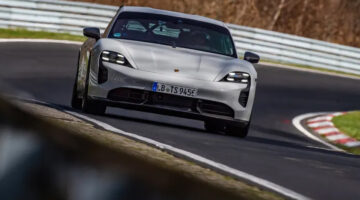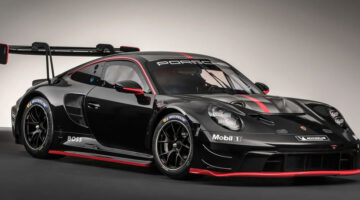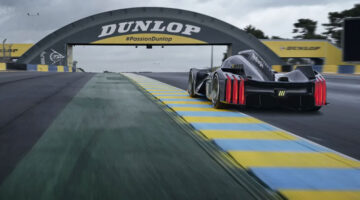It’s been revealed that Porsche ‘would have had no alternative’ but to return to F1 had parent Volkswagen Group blocked the marque’s much hyped return to Le Mans this year, given that it’s been sister company Audi’s turf for more than a decade. Diehard F1 fans may even now be crying into their cereal wondering what might have been. I for one though praise this decision from Volkswagen.
For 2014, Porsche belongs at Le Mans. Not Formula 1.

Let’s talk logistics (aka regulations) to begin with. In 2014, for the first time in the World Endurance Championship, the top of the pops LMP1 prototype category will be split, the hybrid entries from Audi, Toyota and Porsche competing in LMP1-H and entries from Lotus and Rebellion Racing battling it out for LMP1-L (Lightweight) honours. With the 919 Hybrid sharing tech from the company’s already phenomenally powerful 918 Spyder hypercar (which utilises two electric motors, on the front and rear axles, for improved traction), and a chassis – presumably – sharing key fundamentals from sister group Audi’s new R18 e-tron quattro, an LMP1-H podium first time out the blocks for Porsche doesn’t seem all that farfetched.
Now throw in a typically high-attrition race at Silverstone, rejigged line-ups for both Audi and Toyota – with Le Mans legend Allan McNish having hung up his helmet last year, and the Bahrain winning combination of Stéphane Sarrazin, Anthony Davidson and Sébastien Buemi shuffled across Toyota’s two TS040 Hybrids – plus strong pace from Porsche’s 2.0-litre turbocharged four-cylinder engine during pre-season testing. A good result in the team’s first official LMP1 race in 16 years seems rosier than ‘conservative running’ might suggest. Conversely, would an F1 return for a brand new team immediately herald a podium finish? History – if you discount Brawn GP’s ‘phoenix from Honda’s flames’ achievements in 2009 – suggests otherwise.

That’s not to say Porsche’s return to F1 in 2014 wouldn’t have made a mouth-watering spectacle, in much the same way that double points-paying season finales make for a nauseating X-Factor-style TV ‘epic’. New technical regulations, including re-designed bodywork, gearboxes, Kinetic Energy Recovery Systems and new 1.6-litre turbocharged V6 powerplants create a perfect re-leveled playing field for prospective newboys to swoop in and take advantage. And let’s not dismiss that keyword: ‘turbocharged’.
During F1’s last foray into turbo territory, Porsche – together with McLaren – produced a package stronger than any other on the grid, their combined reliability dominating the arguably stronger powerplants from BMW, Ferrari, Renault and Honda. In its first full season back in 1984, Porsche engines sealed the constructor’s championship for McLaren (and Niki Lauda his third driver’s championship) having amassed almost three-times the points of nearest rival Ferrari, and all but four of that year’s 16 victories. In 1985, even up against a rejuvenated Ferrari, Alain Prost took the first of his four championship crowns and the second consecutive constructor’s title for a Porsche-powered car. Compare that with Porsche’s sporadic works team entries between ’57 and ’62, which yielded just one victory and four podiums courtesy of Dan Gurney. Porsche clearly knows what it’s doing with turbo-technology (which, again, will prove quite handy in the WEC this year).

A hot F1 prospect then, but a risky one. As pre-season testing shows, even four-time world championship squad Red Bull Racing can get it wrong, the new RB10 rife with cooling issues thanks to an aerodynamic package at pains with Renault’s new V6 engine. Such is the mash-up of performance balancing, more complicated ‘fan friendly’ technical regulations, and TV money – with the bigger teams getting the lion’s share – that the midfield has become a crowded affair. Breaking into or away from the low points scoring positions against a dozen cars separated by mere tenths of a second lap-to-lap will consequently prove much harder than Porsche’s last ill-conceived dalliance with F1 (which brought a string of DNQs and retirements with Footwork in 1991). Given also the struggles of Toyota, BMW, Jaguar and even Mercedes in recent memory, there’s no guarantee of quick success for works teams in F1’s ever-tougher arena, and patience is rarely a virtue in manufacturer boardrooms.

Whilst the might of Porsche and Ferrari may not meet on the F1 playing fields for some time, the 16-time Le Mans winners will this year go head-to-head with current top dogs, Audi. It’s a truly unique opportunity, the two biggest names in sportscar/LMP1 over the last forty years offering fans and spectators the chance to see who really is the best, in much the same way that the other big questions – Michael Schumacher or Ayrton Senna?; Tom Kristensen or Jacky Ickx?; Sebastien Loeb or Tommi Mäkinen? – will never be answered. Audi will not be ready to relinquish its 13th victory at the 24 Hours of Le Mans in much the same way Porsche will not want to give up victory number 17. Something has got to give, and fans will surely be out in force to see which one does.
For 2014, Le Mans was always going to be the choice for Porsche. There really was no alternative.



